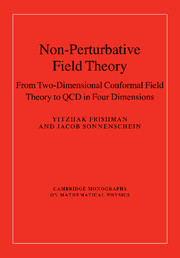Book contents
- Frontmatter
- Contents
- Preface
- Acknowledgements
- PART I NON-PERTURBATIVE METHODS IN TWO-DIMENSIONAL FIELD THEORY
- PART II TWO-DIMENSIONAL NON-PERTURBATIVE GAUGE DYNAMICS
- 8 Gauge theories in two dimensions – basics
- 9 Bosonized gauge theories
- 10 The 't Hooft solution of 2d QCD
- 11 Mesonic spectrum from current algebra
- 12 DLCQ and the spectra of QCD with fundamental and adjoint fermions
- 13 The baryonic spectrum of multiflavor QCD2 in the strong coupling limit
- 14 Confinement versus screening
- 15 QCD2, coset models and BRST quantization
- 16 Generalized Yang–Mills theory on a Riemann surface
- PART III FROM TWO TO FOUR DIMENSIONS
- References
- Index
13 - The baryonic spectrum of multiflavor QCD2 in the strong coupling limit
Published online by Cambridge University Press: 07 September 2010
- Frontmatter
- Contents
- Preface
- Acknowledgements
- PART I NON-PERTURBATIVE METHODS IN TWO-DIMENSIONAL FIELD THEORY
- PART II TWO-DIMENSIONAL NON-PERTURBATIVE GAUGE DYNAMICS
- 8 Gauge theories in two dimensions – basics
- 9 Bosonized gauge theories
- 10 The 't Hooft solution of 2d QCD
- 11 Mesonic spectrum from current algebra
- 12 DLCQ and the spectra of QCD with fundamental and adjoint fermions
- 13 The baryonic spectrum of multiflavor QCD2 in the strong coupling limit
- 14 Confinement versus screening
- 15 QCD2, coset models and BRST quantization
- 16 Generalized Yang–Mills theory on a Riemann surface
- PART III FROM TWO TO FOUR DIMENSIONS
- References
- Index
Summary
We are now going to compute the baryonic spectrum of QCD2, for which as it turns out the bosonic formulation is very convenient. The mesonic spectrum was found earlier, using large N with quark fields as variables in Chapter 10, as well as using currents as building blocks in Section 11.3. For the baryon spectrum, however, the large N limit, in terms of fermionic fields, is not the natural framework to use since in such a picture the baryon is a bound state of a large number N of constituents. Instead, it will be shown in this chapter that the bosonized version of QCD2 in the strong coupling limit provides an effective description of the baryons. We will start by deriving the effective action at the strong coupling limit. It will be argued that for the purpose of extracting the low-lying baryons, one can in fact use the product scheme instead of the U(Nc × Nc) scheme, with the former being more suitable for our purposes. Once the effective action is written down we will search for soliton solutions that carry a baryon number. It will be shown that for a static configuration the effective action reduces to a sum of sine-Gordon actions. Using the knowledge acquired on solitons, in Chapter 5, it will be easy to write down the classical baryonic configuration. We will then semi-classically quantize these solitons.
- Type
- Chapter
- Information
- Non-Perturbative Field TheoryFrom Two Dimensional Conformal Field Theory to QCD in Four Dimensions, pp. 237 - 264Publisher: Cambridge University PressPrint publication year: 2010



